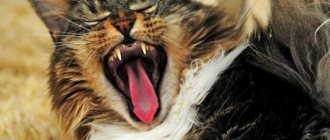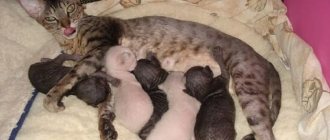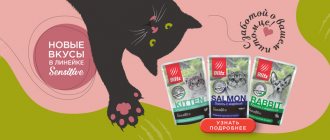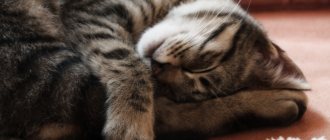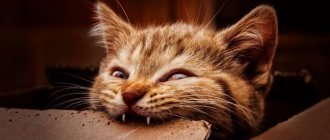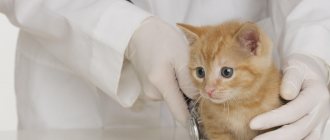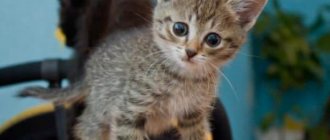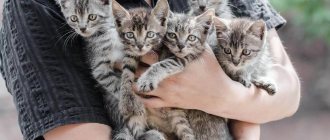Kittens, like other pets, are born without teeth. As kittens grow older, they develop baby teeth one after another, which are eventually replaced by permanent teeth. The process of the appearance and change of teeth usually goes unnoticed for owners, as it usually takes place without any complications.
Knowledge of the process of changing baby teeth to permanent teeth will allow kitten owners to promptly notice and eliminate possible problems in the kittens’ oral cavity.
Formation of a cat's dental bite.
A kitten's milk teeth begin to erupt from the 2nd week of life and finish erupting by 6-8 weeks of age. In total, by the age of 2 months, a kitten has 26 milk teeth, which form the cat’s bite.
The order of eruption of baby teeth in a cat.
The kitten's incisors are the first to erupt at 2-4 weeks of age. At 3-4 weeks of age, fangs appear. Premolars appear in a kitten at the age of 6-8 weeks.
A kitten's emerging baby teeth are thinner than their permanent teeth. The baby teeth will serve the kitten for several months. If the cat has enough milk, and the kittens are given balanced supplementary feeding in a timely manner, there is no lag in weight gain and development, the replacement of milk teeth with permanent teeth will begin at the age of 3–4 months.
How do baby teeth change to permanent teeth?.
The replacement of baby teeth with permanent teeth in a kitten begins at 3-5 months of age and ends at 7-8 months, when 30 permanent teeth form a permanent molar bite. Constant contact and mechanical irritation causes destruction of the roots of baby teeth, which stimulates loosening and their loss.
The process of replacing baby teeth with permanent teeth is usually painless and goes unnoticed for cat owners.
The resulting permanent dentition in a cat is represented by:
- 12 incisors (6 incisors each on the lower and upper jaws).
- 4 fangs (two on each jaw, running along the edges of the incisors).
- 10 premolars (start behind the canines, with 6 premolars in the upper jaw and 4 premolars in the lower jaw).
- 4 molars (2 on each jaw). These 4 molars in the cat are missing in the primary dentition.
The order of replacement of baby teeth with permanent teeth.
The replacement of milk teeth with permanent ones in a cat occurs in the same order as the appearance of milk teeth.
- First, at 4-5 months, the incisors are replaced.
- Then, at 4-6 months, the fangs are replaced.
- At 5-6 months, the premolars are replaced.
- At the end of the 6th month, molars grow.
Symptoms of teething and changing teeth
In most cases, the period of teething and changing teeth in a kitten proceeds almost unnoticed by the owner, but there are a number of symptoms that the owner should pay attention to. And when they appear, for the health of the kitten and your own peace of mind, it is better to visit a veterinarian.
- Refusal to eat or decreased appetite.
If the gums are sore, the kitten may refuse solid food offered. In the event that the refusal to feed continues for more than a day, this should attract your attention.
- The kitten begins to bite toys, bedding, and the owner’s hands. Kitten owners should stop hand biting immediately because... this can lead to him developing a bad habit.
- There is a smell from the oral cavity (cat's bad breath).
In most cases, unpleasant odor from the mouth appears when changing teeth. It is necessary to regularly examine the kitten's oral cavity, paying attention to severe redness or the appearance of ulcers on the mucous membrane.
- The molar has erupted, but the baby tooth has not yet fallen out
A similar situation in kittens occurs quite often and is explained by the fact that the molars grow from a different socket than the milk teeth. That is, physiologically, the molar does not “push out” the milk tooth. This situation shouldn't be scary for a while.
If the teeth in the oral cavity do not interfere with each other, the gums and mucous membrane of the oral cavity are not inflamed, owners should not worry. Not a single kitten in the world has a double set of teeth, which means that your kitten will sooner or later lose its “double set”. But if baby teeth interfere with the growth of molars, inflammation of the gums and oral mucosa occurs, and the teeth injure the tissues of the oral cavity, then the kitten’s owner will need to contact a veterinarian.
The kitten is teething: how to help him
Cutting sharp teeth through sensitive gums always causes physical discomfort, but according to Greencross Vets, it's usually minimal.
The kitten will try to reduce the pain and irritation associated with teething. He may even try to use his owner as a chewing toy, which the latter is unlikely to like. In this case, as during other aggressive cat games, you need to switch the kitten’s attention to something else.
One safe item to use as a chew toy is a cool, damp washcloth. You can chew on it as much as you like, and this will help reduce discomfort. Fabric toys and braided ropes are also suitable.
Alternatively, you can purchase kitten chew toys from a pet store, such as those made from nylon that are easy to chew or those that can be kept in the freezer. For the safety of the kitten, it is better for the owner to be nearby while he plays with these toys. In all cases, you should follow the manufacturer's instructions and check toys for integrity, immediately discarding damaged ones.
The kitten may try to chew furniture legs or wires. Such actions can not only lead to damage to things, but also cause harm to the pet. “To prevent accidental injury from destructive chewing, cover electrical cords and wires with protective plastic covers,” advise Your Cat. They also suggest placing double-sided tape on the areas you want to protect from your kitten's sharp teeth.
Possible complications when changing teeth in a kitten
When changing teeth, a kitten may experience the following types of complications:
Gum inflammation
Teething or the replacement of milk teeth with permanent teeth may be accompanied by a minor inflammatory process, which goes away on its own after the complete formation of the dentition. If you feed your kitten incorrectly, gum inflammation may prolong.
Symptoms. Inflammation of the gums (gingivitis) in a kitten is accompanied by severe drooling (the cat drools). The kitten strives to chew everything. Due to increased soreness of the gums, the kitten's appetite may decrease. Upon visual examination of the oral cavity, we note redness and swelling of the gums.
Treatment. Inflammation of the gums usually goes away on its own after changing teeth. It is necessary to switch the kitten to soft food, which will prevent irritation of the gums.
Residual (“stuck”) baby teeth
In kittens, baby teeth often do not fall out until the permanent tooth emerges from the gums. Residual teeth can disrupt the bite due to abnormal molar growth and cause injury to the cat's gums, cheeks, and lips. In case of such complications, the kitten's owner will need to contact a veterinary clinic.
Symptoms. When examining the oral cavity over the age of 6 months, we find baby teeth.
Beneath the loose baby teeth we find signs of growth of permanent teeth.
Treatment. Veterinary specialists of the clinic, after a clinical examination of the oral cavity, if it is impossible for baby teeth to fall out on their own, these baby teeth are removed surgically under anesthesia.
Formation of primary dental occlusion
Almost all mammals are born toothless. Cats are no exception: the oral apparatus of a newborn kitten is maximally adapted for effective sucking. After all, the only food available to him is mother’s milk.
At two weeks of age, kittens develop milk teeth - straight, small, sharp, milky white. In adult cats they are powerful and curved. They are called milk teeth because they appear in kittens during breastfeeding.
Interesting! The front milk teeth of kittens are straight, and the fangs are curved.
Teething order
The eruption period lasts up to two months. By this age, the cat already has 26 baby teeth. They do not appear all at once, but in a certain order:
- 2–4 weeks. Incisors appear. First, 2 in the center of the jaw, then 4 more are added to them on both sides. There are 12 incisors in total - 6 each on top and bottom.
- 3–4 weeks. Fangs appear: 4 upper and 4 lower. They are located on the sides of the incisors.
- 4–8 weeks. The appearance of pre-masticating teeth - premolars: 4 on the lower jaw and 6 on the upper jaw.
Important! Milk teeth will serve kittens up to the age of 3-4 months with proper care and timely introduction of complementary foods.
Oral hygiene for a kitten
During the change of teeth, oral hygiene in a kitten becomes important. It is necessary to teach a kitten to oral hygiene from a very early age, so as not to suffer in the future with an adult cat.
They usually start with a game - when the kitten begins to get used to a special toothbrush for animals and stops being afraid of it. The kitten will be happy to grab the bristly brush, especially when his gums itch. The main thing is to do this constantly, then the cat will get used to this hygiene procedure.
This will allow you to avoid problems such as tartar (tartar in cats) and the development of periodontitis in the future.
Features of feeding a kitten during the period of dentition change
During this difficult period for a kitten, special attention should be paid to the immune system, namely its protection and strengthening. The pet must be provided with a complete, balanced diet. Products in the diet should be enriched with vitamins and mineral elements necessary not only for strengthening the body's defenses, but also for the active growth of new, permanent healthy and strong teeth.
The basis of the daily diet is foods enriched with calcium and phosphorus. These are elements that promote the proper growth of strong and healthy bone tissue, including teeth. The menu should include dairy and fermented milk products, and porridge is a must. Cereals boiled in milk or water are a source of carbohydrates, which are necessary to meet the energy needs of the animal's body.
It is also necessary to give the baby meat, but lean meat, and it is advisable to cut it into small pieces. If meat is given raw, it must be pre-frozen so that pathogenic bacteria, viruses and intestinal parasites are completely destroyed under the influence of low temperatures.
You should not overuse fish; it is enough to give it no more than 1, maximum 2 times a week.
To replenish all the necessary vitamins and minerals, it is recommended to give your pet commercial dry food during the period of replacement of baby teeth. Moreover, commercial diets are produced that are specially designed for kittens during the period of loss of milk teeth. Such nutrition performs several functions at once - the animal receives all the necessary microelements, hard granules have a beneficial effect on the gums, accelerating the process of loss of baby teeth and the growth of permanent incisors.
During the period of growing new teeth, the kitten experiences quite painful sensations, so the owner must pay as much attention as possible to alleviate the pet’s condition. You need to constantly play with the kitten, so it will be distracted from the unpleasant sensations in the mouth and fall asleep better at night.
There is no need to scold your pet for chewing furniture, especially sofa arms. It is better to buy special toys. This is the best remedy to help a kitten during teething.
Some kittens try to chew on their owner's hands, but such actions must be stopped immediately so that this does not become a habit, since the cat will continue to do this into adulthood.
If the kitten experiences quite severe pain, special dental gels will help. But they only give a short-term effect, so they should be applied in the evening before bed so that the animal can fall asleep without problems.
It is not recommended to purchase special teethers intended for people. Kittens' teeth are quite sharp, so they can easily bite off a piece of rubber and swallow it, which can result in digestive problems.
If the animal does not want to use specialized toys, but continues to chew on household items, the owners need to be patient, regularly explain and show the pet that there are special items for its needs, and everything else is taboo. If this is not done, after replacing baby teeth with permanent ones, the habit of damaging shoes and furniture will remain.
Also watch the video of kittens changing teeth:
Cat jaw structure
Typically, the jaws of cats are well developed and have a peculiarity: the movement of the lower jaw occurs only vertically. The animal bites the food, as if cutting it.
Each tooth has enamel, dentin, pulp and root (1-3), as well as its own role. Let's open the cat's mouth and see that in front there are 12 incisors for holding prey in the mouth.
Next are long fangs, firmly seated in the bone: two below, two above. Their function is to grind food, and they also help in hunting and self-defense.
Behind the canines, premolars and molars are visible, which allow them to chew food and grind bones.
At what age do cats normally lose their molars and in what order?
In adulthood, these animals should not lose teeth. Normally, they fall out once during their life - when changing temporary units to permanent ones. Some people mistakenly think that tooth loss in older animals is normal. However, even in old age this should not be the case. In all cases, tooth loss in cats is a consequence of some internal or external problem.
Care and feeding
Changes in teeth in cats can make themselves felt as early as six months later, so owners should know how to properly care for their pet so that the process goes faster and less painfully. It is important to monitor the behavior of British cats and representatives of other breeds, preventing them from chewing furniture, shoes and other objects in the house. As a relief, the kitten is capable of biting the owner's fingers or toes, but this should not be allowed, since the habit can become a serious problem in the future. During the period of teeth change, it is worth observing a special diet, adhering to the following recommendations:
To ensure a sufficient amount of calcium for the animal’s body, it is recommended to include cottage cheese in its diet.
- Avoid very soft food, since the kitten may inadvertently swallow lost teeth, resulting in damage to the esophageal mucosa. It is recommended to introduce food of coarse consistency and large size into the diet.
- The meat is given in large pieces, with preference given to beef, turkey, and chicken. You first need to scald or boil it.
- Add cottage cheese and other fermented milk products, which contain a lot of calcium, to your daily diet.
- It is possible to add drops or small tablets of phosphorus to the main diet. It is possible to purchase such drugs at a veterinary pharmacy, and many of these drugs contain a small analgesic substance that eliminates pain when changing teeth.
- Twice a week the kitten is fed boiled sea fish, for example, hake.
- The diet is replenished with foods filled with vitamins A and D.
- It is recommended to let the kitten chew on special bones, which are previously purchased at a pet store. They consist of vitamin supplements, thanks to which you can not only scratch your gums and strengthen your growing teeth, but also get the necessary vitamins.
Home dental care and prevention
Toothpaste and teeth brushing
If you start brushing your kitten's teeth at an early age, he may be more receptive to it as he gets older and has adult teeth.
Be sure to use a cat-approved toothbrush and toothpaste. Do not use human toothpaste. The toothpaste comes in a variety of flavors for cats, including chicken and tuna.
Find one that your kitty likes and try to brush his teeth at least three times a week, or more if he lets you!
Dental wipes, rinses
As kittens get a little older, they may not tolerate having their teeth brushed. Some animals, especially those with delicate gums, cannot tolerate cleaning but can be disinfected with wipes or pads.
Dental wipes, rinses, and pads will remove plaque deposits from the surface of the tooth. They don't help in removing food particles from the gums, but they are a good thing for cleaning teeth.
These products are best used daily.
Dental treats
Treats are not a substitute for brushing their teeth, but kittens who have adult teeth may benefit from chewing the correct dental cud daily.
They can significantly reduce plaque and tartar by up to 69 percent. To avoid weight gain, be sure to feed only the recommended amount of treats.
The goal of starting early home dental care for your kitten is to prevent periodontal disease as he gets older.
Professional cleaning by a veterinarian may be necessary at some point in your pet's life. But incorporating a kitty dental care routine into your daily schedule can reduce the number of brushings needed in the future.
Cat dental care
Cats also suffer from toothaches just like humans and can also have serious oral problems. The microflora in the mouth can be colonized by pathogenic organisms, which can quickly upset the balance and lead to dental disease.
To prevent dental problems from having a detrimental effect on the health of your four-legged furry cat, a number of preventive measures are required, which include brushing the teeth and proper nutrition for the animal.
Brushing cats' teeth
global $ads_google;
//data-ad-slot=”2475549904″ $ads_google = empty($ads_google) ? false : true; ?> if ($ads_google == false) {?> $ads_google = true; ?> } ?> Should you brush your cat's teeth ? Definitely yes. How to do it right? Simple enough.
So, let’s figure out how to brush your beloved cat’s teeth.
You need to clean both milk and permanent ones. It will be much easier to accustom a kitten to such a procedure than an adult willful purr.
Cleaning is an excellent prevention of problems with the contents of the jaw, and can be done in three ways:
- Red wine is combined with soda, applied to cotton wool and wiped on the fangs and molars, and the resulting pulp is spread over all the teeth. The wine should be cheap because it contains vinegar, which will help the baking soda remove plaque.
- You need to buy fish-scented toothpaste and a regular children's toothbrush. Despite the soft bristles, cleaning is carried out carefully and delicately, since the animal’s gums are very delicate.
- If the animal protests strongly, purchase a cleaning bone.
The cleaning process does not need to be done frequently; it will be enough to carry out this procedure twice a month. If you have questions about the need to brush your teeth more often, consult your veterinarian.
Ultrasonic cleaning of cat teeth
In addition to the manual method, there is also a completely modern one. Many veterinary clinics can clean your cat's teeth with ultrasound .
The advantages of this method include:
- painlessness;
- complete removal of all deposits.
There is one minus - the procedure is performed on the cat only under general anesthesia.
The effect of such cleaning is achieved due to the effect of ultrasound on tartar, which quickly breaks down and flakes off.
The cat's enamel color and health are preserved. At the end of the procedure, the teeth are polished and coated with a fluoride solution.
Cat dental food
The quality of food plays a huge role in the condition of an animal’s teeth: soft food contributes to weakening of the gums and incisors, the appearance of plaque and tartar. Solid food helps the enamel cleanse.
Dry food can serve as a preventive mechanical cleaning of the dental surface. The food is bitten into pieces, saliva is formed and the teeth are washed. Calcium in saliva prevents stone formation.
The content of sodium polyphosphates in dry food will also help.

